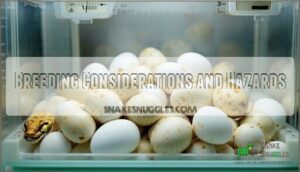This site is supported by our readers. We may earn a commission, at no cost to you, if you purchase through links.

You’ll need to watch for parasites, mites, and respiratory infections that can derail your breeding plans.
Female snakes face unique challenges during reproduction, including egg binding and nutritional depletion.
Temperature and humidity control aren’t just nice-to-haves—they’re make-or-break factors for successful breeding.
Pre-breeding health checks help you spot problems before they become disasters.
Your snakes need proper nutrition, stress-free environments, and careful post-mating recovery time.
Think of it as setting up a five-star hotel for expecting mothers.
Smart breeders know the devil’s in the details regarding preventing complications, and this attention to detail is crucial for successful breeding and ensuring the health of the snakes, making it a key factor in their care.
Table Of Contents
- Key Takeaways
- Snake Breeding Health Essentials
- Key Health Considerations for Breeding Snakes
- Nutrition and Diet for Breeding Snakes
- Environmental Control for Snake Breeding Health
- Recognizing Unhealthy Snakes and Genetic Risks
- Managing Stress and Disease in Breeding Snakes
- Caring for Pregnant or Gravid Snakes
- Breeding Considerations and Hazards
- Post-Breeding Care and Snake Recovery
- Creating a Safe and Healthy Breeding Environment
- Frequently Asked Questions (FAQs)
- How can I ensure healthy snake breeding?
- How do you manage genetic diversity in snakes?
- How do you keep snakes healthy?
- How do you breed a snake?
- How do you know if a snake is ready to breed?
- Do Mama snakes need stress management?
- What do you need to be a snake breeder?
- Do snakes not eat during breeding season?
- What are snakes breeding habits?
- Why do snakes need to be bred?
- Conclusion
Key Takeaways
- You’ll need to monitor your breeding snakes constantly for egg binding, respiratory infections, and parasites that can derail your entire breeding program and threaten your animals’ health.
- You must maintain precise environmental control with temperatures between 78-88°F and humidity at 50-70% while providing stress-free hiding spots to support successful reproduction.
- You should focus on proper nutrition with protein-rich diets, calcium supplementation for females, and adequate recovery time between breeding cycles to prevent energy depletion and health complications.
- You can’t skip pre-breeding health checks and quarantine protocols—these prevent disease spread and help you identify genetic risks before they impact your breeding pairs and their offspring.
Snake Breeding Health Essentials
When you’re breeding snakes, maintaining their health isn’t just about feeding them properly—it’s about creating conditions that prevent disease, reduce stress, and support reproductive success.
You’ll need to monitor for common breeding complications like egg binding, respiratory infections, and nutritional deficiencies while ensuring your snakes maintain ideal body condition throughout the entire breeding process, which is crucial for reproductive success.
Common Health Issues in Breeding Snakes
When breeding snakes, you’ll encounter specific health challenges that demand your constant vigilance.
These reproductive periods stress your animals’ immune systems, making them vulnerable to various snake breeding diseases and common infections.
Breeding season turns your snakes into immune system underdogs—vigilance becomes your best defense against disease.
Watch for these critical warning signs:
- Egg binding in females – look for straining, lethargy, and swollen abdomens
- Respiratory infections from poor humidity control – listen for wheezing or mouth breathing
- Parasite control issues like mites or internal worms that drain energy reserves
Genetic defects and brumation risks also threaten your breeding program’s success, requiring proactive monitoring.
Role of Nutrition in Snake Health
Proper snake breeding nutrition starts with a protein-packed diet suited to your species.
Feeding frequency increases for females, while males might fast near breeding season.
Prey gutload guarantees maximum nutrition transfer, and calcium supplementation prevents deficiencies, and vitamin absorption from whole prey supports reproduction.
Hydration importance can’t be overstated—dehydrated snakes won’t breed successfully, and obesity prevention through portion control keeps breeding pairs healthy.
Managing Stress and Disease
While good nutrition sets the foundation, protecting your snakes from stress and disease requires constant vigilance.
Quarantine protocols prevent disease spread between animals.
Watch for stress signs like food refusal or aggressive behavior, which weaken immunity against parasites and respiratory infections.
- Mites crawling across scales like tiny vampires
- Wheezing sounds during quiet evening checks
- Lethargy replacing normal curious head movements
Key Health Considerations for Breeding Snakes
When you’re breeding snakes, you’ll face unique health challenges that don’t exist with regular pet care, from egg binding in females to managing stress during the mating process.
Understanding these breeding-specific risks helps you recognize warning signs early and take action before minor issues become serious complications that could harm both your breeding pair and their offspring, which is crucial for successful breeding and the health of the offspring.
Impact of Breeding on Female Snake Health
Female snakes face serious Energy Depletion during reproduction.
Breeding Frequency directly affects their Lifespan Impact – too often weakens immune systems and causes Organ Stress. You’ll notice weight loss, lethargy, and reduced appetite after egg-laying.
Genetic Health suffers when females aren’t given proper recovery time between breeding cycles, compromising future offspring quality.
| Health Impact | Signs You’ll Notice | Recovery Needs |
|---|---|---|
| Energy Depletion | Weight loss, weakness | High-protein meals |
| Organ Stress | Lethargy, poor appetite | Extended rest period |
| Immune Weakness | Frequent infections | Stress-free environment |
| Reproductive Strain | Smaller clutch sizes | Calcium supplementation |
| Overall Decline | Dull scales, aggression | Veterinary monitoring |
Risks Associated With Venomous Snakes
While female health demands attention, venomous snake breeding amplifies every risk.
You’re playing with fire when handling species that can kill.
Here’s what separates survival from tragedy:
- Venom potency varies dramatically—research your species thoroughly
- Envenomation symptoms require immediate recognition and response
- Antivenom access must be arranged before breeding attempts
- Bite prevention through proper tools and handling techniques saves lives
First aid won’t substitute professional medical care.
Importance of Proper Post-Mating Care
Post-mating care determines whether your breeding program thrives or struggles.
Your female snakes need dedicated attention during breeding recovery to bounce back stronger than ever.
- Enhanced postmating nutrition: Offer protein-rich meals to rebuild energy reserves and support female recovery
- Critical hydration importance: Fresh water access prevents dehydration and supports internal healing processes
- Stress reduction monitoring: Watch behavior changes closely while maintaining calm, quiet environments for ideal breeding recovery
Nutrition and Diet for Breeding Snakes
Your breeding snakes need more than just regular meals—they require specific nutrition to support reproduction and maintain their health throughout the demanding breeding process.
You’ll discover that proper feeding schedules, targeted supplements, and species-appropriate prey sizes can make the difference between breeding success and costly health complications.
Dietary Requirements for Breeding Snakes
Nutrition becomes your breeding program’s foundation.
You’ll need a protein-packed diet with appropriately sized prey—think mice or rats matching your snake’s girth.
Prebreeding nutrition requires consistent feeding schedules, avoiding fasting periods that drain energy reserves.
Monitor hydration importance through fresh water access.
Proper prey nutritional value prevents nutritional deficiencies while supporting snake breeding health and preventing obesity prevention issues.
Supplements for Breeding Snakes
Beyond proper feeding, your breeding snakes need targeted supplements for peak health.
Calcium supplementation with Vitamin D3 strengthens bones and prevents egg-binding in females.
Multivitamin benefits include supporting immune function, while probiotic use aids digestion.
Fatty acids boost cellular health.
Consider calcium supplements for snakes to guarantee proper bone development.
These dietary supplements prevent nutritional deficiencies and optimize prebreeding nutrition for successful reproduction.
Feeding Strategies for Optimal Health
Strategic feeding creates the foundation for successful breeding.
Your snake’s health depends on these critical factors:
- Prey size should match your snake’s girth – too large causes regurgitation, too small provides inadequate nutrition
- Feeding frequency increases for gravid females who need extra energy reserves for egg development
- Dietary variety with proper supplement timing prevents nutritional deficiencies and supports ideal reproductive health
A well-fed snake breeds successfully.
Environmental Control for Snake Breeding Health
You can’t just toss your snakes into any old enclosure and expect healthy offspring – environmental control makes or breaks your breeding success.
Getting the temperature, humidity, and lighting right creates the perfect conditions for your snakes to thrive and reproduce safely, which is crucial for breeding success.
Setting Up a Breeding Enclosure
Your breeding enclosure needs proper enclosure size—think spacious studio apartment, not cramped closet.
Choose substrate that’s absorbent yet easy to replace during cleaning protocols. Install reliable heating methods away from direct snake contact.
Guarantee solid security measures with tight-fitting lids and locks. Good ventilation prevents stagnant air while maintaining ideal conditions for successful breeding.
Selecting the right sized habitat is vital for snake well-being.
Managing Temperature and Humidity
Perfect temperature gradients create your snake’s ideal comfort zone—like having separate rooms for lounging and basking.
Maintain snake breeding temperature between 78-88°F with humidity levels at 50-70% for ideal snake breeding health.
Seasonal adjustments and brumation effects naturally trigger breeding behaviors, so gradually lower temperatures monthly.
Use humidity monitoring tools and thermal imaging for precise temperature control.
Regular equipment maintenance prevents dangerous fluctuations that stress your snakes and sabotage breeding success.
Providing a Natural Day-Night Rhythm
Temperature and humidity work together with lighting to create the perfect snake breeding environment.
Your snake’s internal clock depends on consistent photoperiods that trigger melatonin production and seasonal breeding cycles.
Proper light cycle benefits include improved appetite, reduced stress, and enhanced reproductive readiness.
- 12-hour on/off schedule: Maintain consistent photoperiods for ideal snake breeding health
- Gradual seasonal adjustments: Mimic natural seasonal light changes over several weeks
- UVB exposure timing: Provide morning UVB exposure to support calcium absorption and breeding condition
Recognizing Unhealthy Snakes and Genetic Risks
You’ll need to spot health problems early and understand genetic risks before your snakes ever mate, since breeding sick animals or carriers of harmful genes can create serious complications for both parents and offspring.
Learning to recognize warning signs like respiratory issues, parasites, and genetic defects in popular morphs will save you from heartbreak and help you make responsible breeding decisions that protect your snakes’ wellbeing.
This understanding is crucial for making informed decisions, and recognizing these signs will help you avoid serious complications for both parents and offspring.
Identifying Signs of Health Issues in Snakes
Five warning signs reveal when your snake needs veterinary attention.
Watch for shedding problems like stuck skin, respiratory issues with wheezing sounds, unexplained weight loss, unusual lethargy signs, or sudden aggressive behavior.
These signs of stress in unhealthy snakes signal potential problems.
Regular monitoring of snake health basics helps catch issues early, ensuring your snake breeding health stays on track.
Understanding Genetic Risks and Responsible Morph Selection
Morph genetics can bite back if you’re not careful.
When breeding for specific looks, you might accidentally concentrate recessive genes that cause genetic defects.
Some morphs carry hidden health concerns like neurological issues.
Ethical breeding means prioritizing genetic diversity over flashy patterns.
Think of it as building a strong foundation—you wouldn’t use weak materials for your house, right?
Research snake breeding genetics thoroughly and avoid inbreeding to minimize genetic risks.
Managing Stress and Disease in Breeding Snakes
You’ll face various health challenges when breeding snakes, from respiratory infections to parasites that can quickly spread through your collection.
Managing these issues requires consistent monitoring, proper quarantine protocols, and creating stress-free environments that support your snakes’ immune systems during the demanding breeding process.
Creating stress-free environments is crucial as it supports your snakes’ immune systems during the breeding process.
Addressing Health Issues in Breeding Snakes
How do you tackle snake breeding health considerations when problems arise? Start with quarantine protocols to prevent infections from spreading between your breeding pairs.
Quick intervention saves both time and heartache down the road.
- Implement strict quarantine protocols for new arrivals
- Maintain parasite prevention through regular screenings
- Monitor for genetic defects in offspring
- Watch for egg binding symptoms in gravid females
- Address snake breeding infections immediately with veterinary care
Managing Stress in Pregnant Females
Once you’ve addressed health issues, female snake health during pregnancy demands careful stress management. Pregnant females face increased stress from hormonal changes and physical demands.
Create a stress-free environment by maintaining consistent temperatures, reducing noise, and limiting handling techniques to essential health checks only. Enclosure security prevents escape attempts that spike stress levels.
Nutritional support with appropriately sized prey helps manage pregnancy demands. Brumation effects can complicate pregnancy, so monitor closely.
Keep veterinary access readily available for emergencies. These snake breeding health considerations guarantee successful reproduction while protecting maternal wellbeing throughout the breeding process.
Dealing With Unfertilized or Dead Eggs
Handling unfertilized or dead eggs is a delicate task.
Use the candling technique to check egg viability—unfertilized eggs appear clear, while dead embryos show shadows.
Remove these eggs promptly to avoid contamination and protect maternal health.
Wear gloves for safety and make certain of proper disposal.
Incubation problems, like incorrect humidity or temperature, can impact egg development.
These issues, often linked to nutrient deficiency or genetic factors, may lead to failure to thrive.
A clean, stress-free environment supports overall snake egg health.
Caring for Pregnant or Gravid Snakes
Caring for a pregnant or gravid snake means ensuring her environment, diet, and stress levels are perfectly managed.
You’ll need to monitor her health closely, as even small changes can impact her well-being and the development of her eggs.
Identifying Pregnancy in Snakes
Spotting pregnancy in snakes can feel like solving a mystery, but a few clear signs can guide you. Gravid females often show behavior changes and physical clues that are easy to spot if you know what to look for.
Here are the top indicators:
- Appetite increase: Your snake may eat more than usual, preparing for the energy demands of egg development.
- Swollen belly: Look for a firm, noticeable bulge along the midsection.
- Reduced activity: Pregnant snakes tend to rest more, conserving energy.
For confirmation, you can try gentle palpation methods to feel developing eggs or use ultrasound imaging for a more precise view of pregnancy signs.
Dietary and Environmental Needs
During pregnancy, your snake needs a balanced environment and diet to thrive. Offer prey sized appropriately for her species and stage of pregnancy. Always provide fresh water and choose a substrate that maintains proper humidity levels while being easy to clean.
Keep her enclosure spacious enough for movement but cozy enough to retain warmth and security. Consider specialized options for pregnant snake nourishment to support maximal health.
Here’s a quick guide:
| Factor | Optimal Range | Tips |
|---|---|---|
| Temperature | 78-85°F | Create a hot zone for metabolic boost |
| Humidity Levels | 50-70% | Use a hygrometer for monitoring |
| Substrate Choice | Moisture-retaining types | Avoid dusty or overly dry materials |
Consistent environmental monitoring guarantees her comfort. Think of it as setting the stage for a smooth pregnancy!
Monitoring Health and Development
Keep a close eye on egg growth rates and perform regular parasite checks to safeguard your snake offspring’s health.
Monitor shedding issues and weight changes in gravid females to catch problems early.
Consistent health assessments guarantee smooth development.
Don’t forget genetic screening—it’s essential for predicting potential issues.
These health considerations set the stage for strong, healthy hatchlings and a successful breeding season.
Breeding Considerations and Hazards
When breeding snakes, you’ll need to balance species selection with ethical practices to avoid unnecessary risks.
Poor planning, like inbreeding or choosing aggressive species, can lead to health issues and complications for both snakes and breeders.
Choosing Docile and Beginner-Friendly Snake Species
Starting with beginner snake breeds like corn snakes or ball pythons is smart.
These docile snake species are known for their gentle temperament and manageable size.
Here’s why they’re great:
- Temperament considerations: Easy to handle, even for nervous hands.
- Size requirements: Compact enough for smaller enclosures.
- Docile snake care: Low maintenance, making them perfect for beginners prioritizing snake health and stress-free handling techniques.
Risks Associated With Inbreeding Snakes
Inbreeding snakes can lead to genetic defects, reduced immunity, and lower fertility, jeopardizing offspring viability.
It’s like rolling loaded dice—you risk health complications that could derail your breeding goals.
Prioritize genetic diversity to avoid these pitfalls and guarantee robust morph health.
Inbreeding Risks Impact
Post-Breeding Care and Snake Recovery
After breeding, your snake needs focused care to recover and regain strength. Proper nutrition, hydration, and a stress-free environment are essential to prevent complications and guarantee a smooth recovery.
Care for Female Snakes After Mating
Caring for a female snake after mating is vital for her recovery and future health. Think of it as her well-deserved spa day—only longer! Focus on nutritional support and hydration importance to help her bounce back.
- Offer nutrient-packed meals to restore her energy.
- Maintain constant access to fresh water for hydration.
- Keep her enclosure enriched with clean, cozy hiding spots.
- Monitor her health for signs of stress or weight changes.
Good postmating care ensures smoother postlaying recovery and sets her up for balanced health and future success.
Recovery Time for Breeding Snakes
After mating, your snake deserves a restful postpartum period. Offer a stress-free space with minimal handling and a cozy hide.
Focus on post-breeding nutrition and hydration importance to rebuild energy. Regular veterinary checkups guarantee smooth postlaying recovery.
Brumation effects may linger, so patience is key. Recovery time varies, but attentive breeding snake care keeps them healthy and ready for future adventures.
| Key Recovery Tips | Why It Matters | How to Implement |
|---|---|---|
| Stress Reduction | Promotes healing | Quiet, low-traffic area |
| Post-Breeding Nutrition | Restores energy | Protein-rich meals |
| Hydration Importance | Prevents dehydration | Fresh water daily |
| Veterinary Checkups | Detects complications | Schedule follow-ups early |
Preventing Post-Breeding Complications
Preventing post-breeding complications is key to female snake health.
Follow these steps for proper postbreeding care:
- Hydration: Provide fresh water to aid recovery and prevent prolapse risks.
- Nutrition: Offer a diet rich in calcium and vitamins to support maternal recovery and prevent egg binding.
- Health Monitoring: Watch for signs of dystocia or infection; consult a reptile vet if needed.
- Stress Reduction: Maintain a calm, clean environment to facilitate smooth recovery.
Creating a Safe and Healthy Breeding Environment
Creating the right breeding environment isn’t just about comfort; it’s essential for your snakes’ health and reproductive success.
By controlling temperature, humidity, and providing secure nesting spaces, you’ll set the stage for safe and stress-free breeding.
Maintaining Proper Temperature and Humidity Levels
Keeping your snakes comfortable means mastering temperature gradients and humidity control. Aim for species-specific temperature requirements, typically between 78-88°F, and maintain humidity levels around 50-70%.
Use reliable tools like thermal imaging and hygrometers for precise monitoring. Remember, brumation effects may require gradual cooling for some species.
Ventilation, proper substrate, and regular equipment maintenance are key for stability. Think of it like baking—get the balance right, and your snakes will thrive.
Here’s a quick guide:
| Factor | Ideal Range | Tools Needed |
|---|---|---|
| Temperature | 78-88°F | Thermometer, Heat Mat |
| Humidity | 50-70% | Hygrometer |
| Substrate Choice | Holds moisture | Coconut Fiber |
| Ventilation | Good airflow | Screen Lids |
| Monitoring | Consistent checks | Thermal Imaging |
Providing Appropriate Hiding Spots and Nesting Areas
Your breeding enclosure should feel like a secure retreat for your snakes.
Prioritize enclosure security with a snug, escape-proof design. Use a soft substrate choice like sphagnum moss, paired with cozy hiding spots and a proper substrate hidebox for nesting.
Offer hiding variety to mimic natural environments, such as logs or plants. Make certain space requirements allow free movement.
Stable temperatures and comfy nesting materials keep snakes happy, while a thoughtfully crafted nesting area supports excellent snake breeding health.
Frequently Asked Questions (FAQs)
How can I ensure healthy snake breeding?
Picture your serpents thriving in perfect harmony—healthy breeding starts with maintaining 78-85°F temperatures, 50-70% humidity.
Feeding protein-rich diets, quarantining new arrivals, and ensuring both partners weigh appropriately before introducing them together.
How do you manage genetic diversity in snakes?
You’ll want to avoid breeding closely related snakes and introduce new bloodlines regularly.
Keep detailed records of parentage, rotate breeding pairs annually, and source animals from different breeders to maintain healthy genetic variation.
How do you keep snakes healthy?
Smart snake stewardship starts with stable temperatures between 78-85°F, proper humidity levels, and nutritious prey.
You’ll monitor for parasites, provide clean water, maintain quarantine protocols, and guarantee stress-free environments with appropriate hiding spots.
How do you breed a snake?
Condition your snakes with proper nutrition and stable temperatures first.
Choose healthy, compatible pairs, then simulate seasonal changes to trigger breeding behavior.
Monitor mating, provide nesting areas, and maintain ideal incubation conditions.
How do you know if a snake is ready to breed?
Like a well-tuned engine, your snake’s readiness shows through specific signs. Check if females weigh at least 1,200 grams and males reach 700 grams, plus they’re healthy, well-fed, and displaying breeding behaviors.
Do Mama snakes need stress management?
Yes, pregnant snakes absolutely need stress management.
You’ll want to minimize handling, provide hiding spots, maintain consistent temperatures, and keep their environment quiet.
Stress can cause egg-binding and other serious complications during breeding.
What do you need to be a snake breeder?
Ready to enter the snake breeding world?
You’ll need proper enclosures, temperature control equipment, healthy breeding stock, veterinary contacts, incubation supplies.
And most importantly—extensive species knowledge and patience for success.
Do snakes not eat during breeding season?
Male snakes often reduce food intake or stop eating entirely during breeding season, especially when exposed to female pheromones.
This natural fasting behavior can last weeks or months, so don’t panic if your male refuses meals.
What are snakes breeding habits?
Contrary to popular belief, snakes don’t completely stop eating during breeding season.
Males often reduce food intake when detecting female pheromones, while females increase feeding to support egg development and maintain energy reserves, which is a complete concept related to their behavior.
Why do snakes need to be bred?
You don’t need to breed snakes unless you’re passionate about conservation, preserving specific genetics, or contributing to captive populations.
Most pet snakes live fulfilling lives without breeding, requiring only proper care and enrichment.
Conclusion
Successful snake breeders report a 40% reduction in health complications when following proper protocols.
You’ve learned that snake breeding health considerations encompass everything from pre-breeding screenings to post-mating recovery.
Temperature control, nutritional support, and stress management aren’t optional—they’re essential for healthy outcomes.
By monitoring your snakes closely, maintaining ideal environments, and addressing issues early, you’ll create the foundation for successful breeding programs.
Remember, healthy parents produce healthy offspring, making these practices invaluable investments.


















